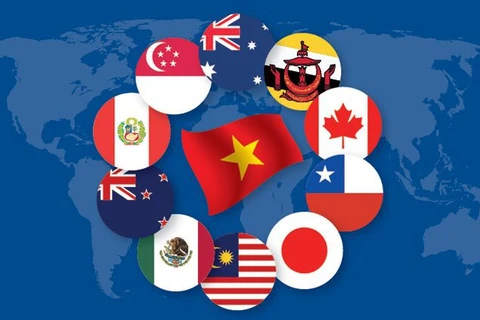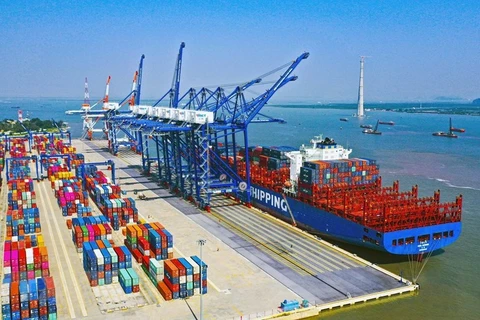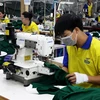Hanoi (VNS/VNA) - Domestic enterprises need to increase their initiative in seizing incentives in the Comprehensive and Progressive Agreement for Trans-Pacific Partnership (CPTPP) to optimise the deal, experts said.
According to Nguyen Cam Trang, deputy director of the Ministry of Industry and Trade (MoIT)’s Import-Export Department, meeting the rules of origin is one of the prerequisites for Vietnamese goods to enjoy preferential tariffs from the CPTPP. However, the awareness of domestic enterprises about the rules has been slow and remained restricted as the rules are relatively complicated and different from those of other free trade agreements.
While enterprises couldn’t follow the rules rapidly, the support of the State management agencies to the enterprises on the issue hasn’t been as effective as expected.
Therefore, to make effective use of the CPTPP, according to Trang, State management agencies should improve the efficiency of enforcement, while continuing to streamline legal documents.
In addition, communications should continue to be focused on providing information related to commitments, tariff incentives and rules of origin in a more specialised direction, going deep into each market, each specific product, with specialised training offered to have a more strengthened impact on specific target groups.
Information on import markets related to taste, capacity and especially management policies should also be provided to businesses for their production orientation.
On the business side, they also need to improve their activity in capturing the above information.
After more than three years of implementing the CPTPP, Vietnam's exports to CPTPP countries have achieved impressive results, especially in new markets such as Canada, Mexico, and Peru. Besides markets with large export turnovers such as the US, China, and EU, other markets in Latin America or Oceania have also gained double-digit growth in import and export turnover.
In the Canadian market, for example, despite difficulties caused by the COVID-19 pandemic, the export of goods from Vietnam to Canada rose 20.8 percent to 5.3 billion USD, according to the Vietnamese Trade Office in Canada. This was the third consecutive year Vietnam gained positive growth in exports to Canada since 2019 when the two countries officially became members of the CPTPP.
Vietnam's agricultural and fishery products have continued to affirm their foothold in the Canadian market. For example, Vietnamese cashew nuts have accounted for 90 per cent of the Canadian market’s total quantity while the numbers for pepper and shrimp were 50 percent and 30 percent, respectively.
According to representatives of the Vietnamese Trade Office in Canada, though Vietnam is currently Canada's largest trading partner in Southeast Asia, opportunities for Vietnamese goods to access the Canadian market is still very large as the market share of Vietnamese goods in the market accounts for only 1.7 percent of Canada's import value. As the Canadian government is continuing to pursue a strategy of market diversification and considering Vietnam an important partner in Asia, it will be a great opportunity for Vietnamese enterprises to access this market.
Tran Thanh Hai, deputy director of the MoIT’s Import-Export Department, said since the CPTTP took effect, export turnover to the CPTPP’s markets has grown impressively.
CPTPP markets, especially American countries like Canada, Mexico, and Peru, were relatively new for Vietnamese exporters before the CPTPP took effect and Vietnamese exports to the markets were modest. However, after the implementation of the CPTPP, Vietnam's export turnover to the markets has increased significantly, according to Hai./.
According to Nguyen Cam Trang, deputy director of the Ministry of Industry and Trade (MoIT)’s Import-Export Department, meeting the rules of origin is one of the prerequisites for Vietnamese goods to enjoy preferential tariffs from the CPTPP. However, the awareness of domestic enterprises about the rules has been slow and remained restricted as the rules are relatively complicated and different from those of other free trade agreements.
While enterprises couldn’t follow the rules rapidly, the support of the State management agencies to the enterprises on the issue hasn’t been as effective as expected.
Therefore, to make effective use of the CPTPP, according to Trang, State management agencies should improve the efficiency of enforcement, while continuing to streamline legal documents.
In addition, communications should continue to be focused on providing information related to commitments, tariff incentives and rules of origin in a more specialised direction, going deep into each market, each specific product, with specialised training offered to have a more strengthened impact on specific target groups.
Information on import markets related to taste, capacity and especially management policies should also be provided to businesses for their production orientation.
On the business side, they also need to improve their activity in capturing the above information.
After more than three years of implementing the CPTPP, Vietnam's exports to CPTPP countries have achieved impressive results, especially in new markets such as Canada, Mexico, and Peru. Besides markets with large export turnovers such as the US, China, and EU, other markets in Latin America or Oceania have also gained double-digit growth in import and export turnover.
In the Canadian market, for example, despite difficulties caused by the COVID-19 pandemic, the export of goods from Vietnam to Canada rose 20.8 percent to 5.3 billion USD, according to the Vietnamese Trade Office in Canada. This was the third consecutive year Vietnam gained positive growth in exports to Canada since 2019 when the two countries officially became members of the CPTPP.
Vietnam's agricultural and fishery products have continued to affirm their foothold in the Canadian market. For example, Vietnamese cashew nuts have accounted for 90 per cent of the Canadian market’s total quantity while the numbers for pepper and shrimp were 50 percent and 30 percent, respectively.
According to representatives of the Vietnamese Trade Office in Canada, though Vietnam is currently Canada's largest trading partner in Southeast Asia, opportunities for Vietnamese goods to access the Canadian market is still very large as the market share of Vietnamese goods in the market accounts for only 1.7 percent of Canada's import value. As the Canadian government is continuing to pursue a strategy of market diversification and considering Vietnam an important partner in Asia, it will be a great opportunity for Vietnamese enterprises to access this market.
Tran Thanh Hai, deputy director of the MoIT’s Import-Export Department, said since the CPTTP took effect, export turnover to the CPTPP’s markets has grown impressively.
CPTPP markets, especially American countries like Canada, Mexico, and Peru, were relatively new for Vietnamese exporters before the CPTPP took effect and Vietnamese exports to the markets were modest. However, after the implementation of the CPTPP, Vietnam's export turnover to the markets has increased significantly, according to Hai./.
VNA























